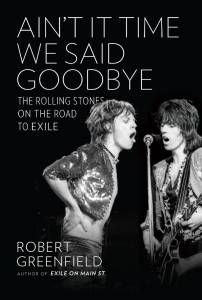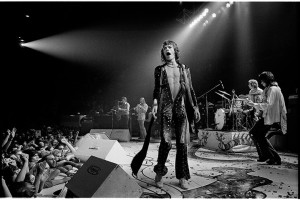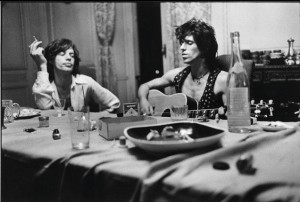At the tender age of twenty-five, journalist Robert Greenfield packed his bags and hit the road with the hard-living, rockin’ Rolling Stones for their 1971 farewell tour of Great Britain.
From Mick’s “shape-shifting ways” to Keith ‘s phantom junkie mystique, Greenfield rode buses, trains and aeroplanes, watching from the wings all the way from Newcastle to New York City, witnessing the Stones as they would never quite be again. He penned three books about his experiences and the latest, Ain’t It Time We Said Goodbye: The Rolling Stones on the Road to Exile, offers page after page of awesome backstage revelations.
Like this:
“As though she was born to pop stardom and has every right in the world to be here tonight, Joyce the Voice, whose trip it is to be all trippy and sometimes walk out onstage to grab the microphone for unscheduled raps no one wants to hear, suddenly appears before the mirror. Talking directly to Bianca, she says, ‘Excuse me, but didn’t I see you with Osibisa in their dressing room last week?’
What? What is this? I mean, hold on. Joyce the Voice has just asked Bianca, she of the inscrutable face, blinding smile, mysterious eyes and gin rummy ways, Joyce has just asked Mick Jagger’s lady, ‘Excuse me, but aren’t you a groupie for this band I know?’
Although the question deserves no response, Bianca is nothing if not polite and so says, ‘What is Osibisa?’
‘Oh wow,’ Joyce says with a completely straight face, not knowing that she has just been cut dead and left lying face down on the dressing room floor. ‘There is someone with your exact vibration walking around. I mean, like a twin sister. You know? Someone walking around with your face.’
As Bianca rolls her eyes upward, Joyce is promptly escorted out the door. Slowly working his way across the room, a skinny old man holding a sheet of paper in his hand comes up to Mick and says, ‘Who’s Mick Jagger now? It’s not for me. It’s an autograph for a little girl, a spastic she is, no legs neither. C’mon now. You are in the group, ain’t ya?’
And while you might think Mick would waste no time having this old man shown the door as well, he very softly says, “Yeah, I am,” and then signs his name on the sheet of paper. ‘Should I steer you to the others?’ Mick asks. ‘That’s Charlie right over there.'”
(Reprinted courtesy of Da Capo Press.)
We caught up with Bob on a hot August afternoon to talk Altamont, Keef’s possible replacement & the unflappable charm and wit of Charlie Watts.
You mention how practiced Keith and Mick were at the art of deception. Talk about the difference between a Mick Jagger interview versus one with Keith Richards.
As I point out in the book, I never actually interviewed anyone while I was on the farewell tour. Because I did not want the Stones and all those who traveled with them to be conscious of the fact that I was there to write an article about the tour for Rolling Stone magazine, I also never took notes where people could see me doing so. Instead, I spent an inordinate amount of time in freezing cold lavatories all over England writing down what I had just seen and heard.
On the bus coming in from the airport in Glasgow, Mick did sit down beside me and grant what I later came to realize was an audience. Unlike Keith, who traveled to every gig on his own accompanied by Anita Pallenberg, their young son Marlon, and Gram Parsons, Mick definitely knew why I was there and so everything he told me was intended for publication. Six weeks after the tour ended, I found myself living at Villa Nellcote, Keith’s palatial pleasure dome by the sea in the south of France. Having never exchanged a single word with him during the tour, I had come there to do the Rolling Stone interview with him. To that point in time, Mick had always been the public face of the band and no one had ever heard Keith say very much about anything. To say that he was an astonishing person to interview would be an understatement of major proportions. To his great credit, the man never dodged a single question. And while he did present everything as he saw it, his level of recollection was extraordinary. Getting him to sit down with me again after our initial session had ended was of course a horse of an entirely different color but in the world according to Keith Richards back then, utter chaos was always a major factor.
What’s your take on Altamont? Professionally, how did the Stones survive?
My take is that the Stones were trying to do a free concert without any idea of what this entailed in America back then. They had fallen out with the legendary rock promoter Bill Graham earlier on this tour and so did not avail themselves of his expertise. Because the band had employed the British Hell’s Angels, many of whom did not even own motorcycles, to provide security for the free concert in Hyde Park in London in July, the Stones thought they could do the same at Altamont. As everyone who has seen Gimme Shelter, the documentary film by the Maysles brothers about that event knows, this proved to be a terrible mistake. In terms of taking responsibility for what happened at Altamont that day, the Stones themselves had already long since become inured to riots breaking out in various European cities before, during, and after their shows. In their view, none of this had much to do with them and all they were responsible for was what went down on stage. The Rolling Stones were able to survive Altamont because once they returned to England, they left what happened that day behind them. Although the release of Gimme Shelter shortly before the English tour began re-awakened the controversy in America, the Stones had by then already completed recording Sticky Fingers, which then became their biggest selling album to date. And so when they returned to America in the summer of 1972, they were bigger than they had ever been before. By then, the counter-culture itself was in disarray and the Stones were on their way to becoming the preeminent rock band in the world.
 Who was more influential in the Exile era: Anita or Bianca?
Who was more influential in the Exile era: Anita or Bianca?
By far, it would be Anita Pallenberg. The love of Brian Jones’ life, she was an immensely powerful human being whose amazing taste in art and fashion helped re-shape the way in which Mick, Keith, and Brian presented themselves to the world. In many ways, Anita was a Rolling Stone and her influence on the band during this period cannot be underestimated. As I point out in the book, Bianca and Anita never got along but since Bianca’s focus was always on Mick, she had far less to do with the direction in which the Stones were going during this period than Anita.
According to Keith: Mick is like dealing with “a nice bunch of guys.” Which Mick do you think prevailed into the 70-year old man still carrying on? Camp icon? Blues boy? Businessman?
Camp icon, no. Brilliant businessman, extraordinary performer, and a far better songwriter than anyone has ever given him credit for, yes. Without Mick, the Stones would not still be touring. During the years when Keith was really out of it, Mick was the one who kept it all together. Had he not brought in Prince Rupert Loewenstein to sort out the band’s incredibly tangled financial affairs, the Stones would never have gone into tax exile in the south of France in the first place and might well have fallen apart back then. Mick was also the one who elected to go with Ahmet Ertegun and Atlantic Records to distribute Rolling Stones Records, a decision that then proved to be incredibly successful for all concerned.
You describe it as “over the top, loud, violent, angry, entirely decadent and incredibly lucrative” – what was it about that ‘72 tour that set the Stones up?
Whenever the Stones toured America back then, they crystallized all the insanity that was going on in the country at the time. Thanks to the great commercial success of Sticky Fingers, the 1972 tour became the highest grossing rock tour in history to that point in time. Due in no small part to Ahmet Ertegun as well as what was going on in the culture, this was also when the Rolling Stones crossed over into the mainstream. Fourteen months earlier, I had been the only writer on the English tour. During the summer of 1972, the Stones traveled from city to city on their own plane accompanied by a huge press contingent and so became headline news wherever they performed.
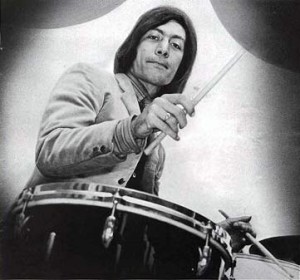 If I simply say “Charlie Watts” – what’s the first things that come to mind?
If I simply say “Charlie Watts” – what’s the first things that come to mind?
Just how a sweet and genuine human being he was back then. Unlike Mick and Keith and Brian, Charlie had never taken LSD and so was in many respects still whom he had always been — a smart and funny jazz aficionado who never seemed all that impressed by any of the insanity going on around him. Along with Ian Stewart, who had begun as the band’s piano player and then became their road manager, Charlie was the heart and soul of the Rolling Stones.
 Your book made me realize that Bobby Keys is the most lovable Stone. I’m mentioning this to give you the floor to tell any Bobby Keys story you wish. Loved every one, but especially his run-in with Yoko Ono who requested he “blow like a lonely frog”.
Your book made me realize that Bobby Keys is the most lovable Stone. I’m mentioning this to give you the floor to tell any Bobby Keys story you wish. Loved every one, but especially his run-in with Yoko Ono who requested he “blow like a lonely frog”.
Larger than life in every possible way, Bobby was a good old boy from Texas who had already spent most of his adult life playing saxophone on the road with everyone from Buddy Knox to Bobby Vee. While I later learned that much of what Bobby Keys told me on that tour was not true, he had been at the Texas State Fair in San Antonio in 1964 when the Stones played before an audience who could not have cared less about their music. Before the Stones went out to do their second show, Bobby seems to have told Brian Jones that in America, bands actually changed their clothes before going out on stage. Being the Stones, the band then exchanged clothes with one another before going on to perform.
The story you mention was actually told by Gram Parsons. Bobby was doing a session with Yoko Ono at which Gram said everyone was snorting Excedrin and “bouncing off the walls.” At one point, Yoko said, “Bobby, imagine there is a cold wind blowing and you are a lonely frog.” As Gram Parsons said, “Bobby Keys a frog. He just laid down his sax and played marimbas and tambourine and said, ‘Lady, yew shore got a strange slant on things. Yeah, starting with your eyes.”
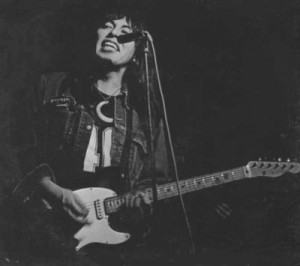 I never realized that with one small twist of fate, Jessie Ed Davis could have replaced Keith Richards in the Rolling Stones.
I never realized that with one small twist of fate, Jessie Ed Davis could have replaced Keith Richards in the Rolling Stones.
In 1973, Keith appeared in court alongside Anita Pallenberg after they had been busted in their home on Cheyne Walk in London for drugs as well as possession of firearms, a far more serious charge which in England then carried with it an automatic sentence of a year in jail. The late Andy Johns was sitting alongside Mick Jagger in the gallery when Mick turned to him and said, “I think Keith’s going down. But it’s all right. I’ve got Jessie Ed Davis with his bags packed in LA. He can be on the next plane.” With the band having just completed Goat’s Head Soup, the Stones were scheduled to go on tour to promote the album and Mick was fully prepared to replace Keith so this could happen. Thanks no doubt to a back room deal, Keith was let off with just a fine and so it never happened. Sadly, Jessie Ed Davis, who was himself a wildly talented guitar player, later died of a heroin overdose.
What do you think were the Stones’ worst blunders? Did they really have any? Do you think they’re pretty satisfied with the course of things?
They made so many blunders during the early days of their career that it would be hard to name the worst one. Deciding to go with Allen Klein as their manager would certainly have to rank right up there, most especially in terms of them giving him control of their masters and publishing. That they are in fact satisfied with all that they have achieved over the past half century goes without saying.
Assuming they’re not still on tour, how will people be explaining the Rolling Stones one hundred years from now?
I really have no idea. What I do know for certain is that in terms of the way Mick and Keith lived their lives back then, the Rolling Stones brought about true social change in both England and America. Marianne Faithfull once said that the Stones were the original punks. No one who was not then around can imagine how shocking their appearance and off stage behavior seemed at the time. Unlike the cute and cuddly Beatles, the Stones were every mother and father’s worst nightmare. No one ever wanted their daughter to go with a Rolling Stone but as we all know, so many did.
What’s the secret insight on the longevity of the world’s greatest rock & roll band?
Right from the start, the Stones were always a band who traveled from one gig to another night after night. That Mick and Keith only really feel alive when they are on stage is the reason they are still out there doing it now. And, as the great Bill Graham would have said, if they were no good, nobody would want to come see them.
Before we go, I’m in Nashville & I’d love a Music City Stones story, if you have one.
It’s hardly a great story but I was with the Stones when they played Nashville on the 1972 tour. I was supposed to cover the entire tour for Rolling Stone magazine but once Truman Capote insinuated himself on to the tour, I was ordered to return to Los Angeles and write my final piece. After I did this, the piece was cut to ribbons and I wound up quitting the magazine. Believing my writing career had come to an end, I was about to pursue other goals when a publisher asked me to write what became the first full length book about a rock tour, STP: A Journey Through America with the Rolling Stones. Plainly, I can still remember getting on that plane in Nashville at the crack of dawn after having been up all night thinking that I would never again have anything to do with the Rolling Stones.
 Back in college, the guy who owned the indie record store had a vinyl copy of Garden State ’78 & another from the ’73 tour. Both were wretched. Out of tune. Out of time. Jagger yawping. Keef stumbling through. We listened to them obsessively because even in the awfulness, there was something undeniably brilliant between the cracks.
Back in college, the guy who owned the indie record store had a vinyl copy of Garden State ’78 & another from the ’73 tour. Both were wretched. Out of tune. Out of time. Jagger yawping. Keef stumbling through. We listened to them obsessively because even in the awfulness, there was something undeniably brilliant between the cracks.
Ah, well, as this was after my time with the band was done, I can only say that the shows I saw them do on the English tour were incredible. No backup singers, just Bobby Keys and Jim Price on horns with Keith singing backup, and either Nicky Hopkins or Ian Stewart on piano. Mick Taylor was then at the height of his powers and played beautifully every night. The shows on the 1972 tour were not as consistently brilliant but I recently watched the Stones doing “All Down The Line” live in Texas and it seemed pretty good to me.
Your book showed me that side of The Stones I so love. Rock & roll absurdity, nothing perfect, everything crashing, everyone wrecked and muddling through, rough and ragged just as true rock & roll should be. You capture the true essence.
Thanks for the compliment. What I do think has been lost about the Stones is the way they were back then. Although Mick and Keith were incredibly complex and complicated creatures who also happened to be great artists and rock stars, they were also just human beings who were trying to deal with a variety of personal and professional problems that would have already put a lesser band asunder. What I’m happiest about in terms of the way this book has been received is that some people seem to have understood this point. To be sure, I was fortunate enough to have the kind of unlimited access to them all that no one would ever have again. But it was in the quiet moments rather than on stage that I got to see who they really were.
Thanks for your time, sir.
As Duane and Gregg Allman seem to have said to one another after every show, “Pleasure jamming with you.”

